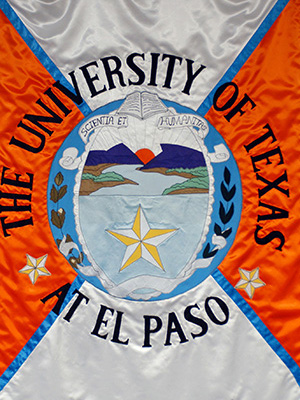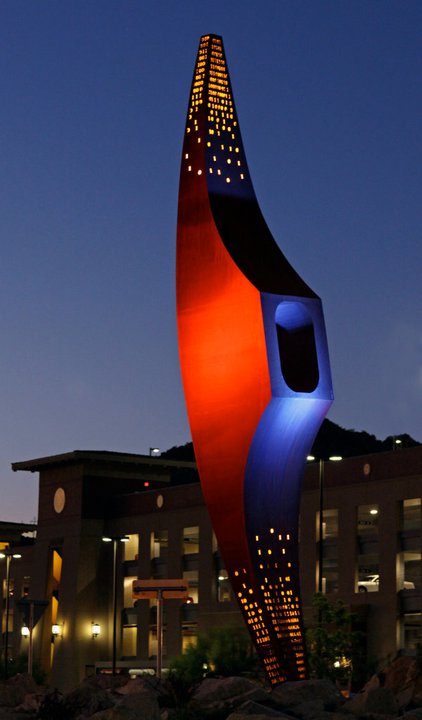History of Commencement

Prior to 1980, The University of Texas at El Paso (and its predecessors, the Texas College of Mines and Metallurgy and Texas Western College) borrowed regalia for ceremonial occasions. In 1980, drama department faculty member C.L. Etheridge suggested that the time had come for UTEP to have its own unique regalia. President Haskell Monroe established the University Heritage Commission to raise funds for the creation of official regalia, to include a mace, chains of office for the President and the Vice President for Academic Affairs, a UTEP banner and seal, and a banner and seal for each of the colleges.
A University seal, depicting El Paso’s sun, mountains and river, had been created for Texas Western College in 1949 by renowned local artist José Cisneros. This seal was incorporated into the official heraldic layout for the University banner designed by Art Department faculty member Sally Bishop Segal, who also designed seals for the colleges of Liberal Arts, Science, Nursing and Allied Health (now the College of Health Sciences), and the Graduate School. Albert Ronke, Drama Department faculty member, designed the seals for the colleges of Business Administration, Education, and Engineering. All eight seal designs in their heraldic layout were then crafted into fabric by Esther “Terri” Cornell. In 2001, the seals for Engineering, Business and Health Sciences were updated by Sally Segal to reflect new programs offered by those colleges.
UTEP alumnus James Love created the Chain of Office for the President, consisting of eight seals reproduced on two-inch diameter enameled disks; the Chain of Office for the Vice President for Academic Affairs; and the University Mace.
C.L. Etheridge developed the ceremonial rituals used in University commencement since 1981.
THE UNIVERSITY MACE

A symbol of authority and dignity of office, the mace has been associated with civil and academic ceremonies from at least the 14th century. The Mace is designed to convey honor, optimism, hope, accomplishment, learning and scholarship, and its association with special events denotes tradition, solemnity and a commitment to excellence. At The University of Texas at El Paso, the Mace plays a prominent role in all Commencement and Convocation ceremonies.
The University Mace is a timeless and inspiring symbol that combines forms selected from the distinctive Bhutanese architecture of the UTEP campus; the natural landscape of the Chihuahuan Desert; and the multicultural heritage of the U.S.–Mexico border region. The Mace captures the University’s rich history as well as its highly promising future, from its beginnings as Texas’ first mining school in 1914 to today’s competitive research university serving a 21st century student demographic.
The University Mace took place as a cherished legacy, an extraordinarily beautiful reminder of UTEP’s first 100 years of commitment to providing higher education opportunities to residents of this U.S.–Mexico border region.
BANNERS
Among the many traditions associated with Commencement, the presentation of the ceremonial University and College banners symbolizes the accomplishments of the graduates whom we honor on this occasion and the University’s commitment to their success. Each banner bears a unique seal placed on a 4 x 6-foot heraldic field, or saltire, and each incorporates symbols and colors that define it:
University Banner
 Colors: Orange, White and Blue
Colors: Orange, White and Blue
Symbols: Open Book – the learning process;
Sun, Mountains and River – the city of El Paso;
Star – The Lone Star of Texas;
Laurel Branch – high academic achievement;
Oak Branch – solidity and permanence
College Banners
Business Administration
Colors: Brown – Business and Accounting; Copper - Economics
Symbols: Flame – depicts knowledge and enlightenment;
Miner’s Pick – represents unity with the University’s identity;
Column – symbolic of strength and an emblematic inference to the importance of international accreditation; Scroll – associated with commerce and contracting;
Laurel Branches – denote academic and professional success;
Globe – international
Education
Color: Light Blue
Symbols: Lamp – lamp of learning;
Book – learning and literacy;
Sigma – Greek symbol for “all-encompassing”;
Book, Ruler and Compass – the tools of learning
Engineering
Color: Dark Orange
Symbols: Castle Structure – civil engineering;
Gear – mechanical engineering;
Bolt of Lightning – electrical engineering;
Hammer and Assaying Scale – metallurgical and mining engineering;
Human Form – industrial engineering;
Computer Card and Binary Numbers – computer science
Health Sciences
Colors: Green – Healing Arts
Symbols: Dark Red Field – blood of life;
White Shield and Red Cross – humanitarian aid;
Human Figure – physical care and therapy;
Beaker, Needle and Test Tube – laboratory research and application
Liberal Arts
Color: White – Humanities, Arts and Letters
Symbols: Alpha/Omega – first and last letters of Greek alphabet symbolizing the scope of studies in Liberal Arts;
Torch – knowledge;
Open Book – the learning process and literacy;
Color Stripes – denote disciplines within liberal arts: Brown for Fine Arts, Crimson for Journalism, Pink for Music, Dark Blue for Philosophy, Violet for Psychology, Scarlet for Religion, Citron for Social Work and Silver Gray for Speech and Drama
Nursing
Color: Apricot
Symbols: Maltese Cross – exceptional service to humanity;
Lamp of Knowledge – tribute to Florence Nightingale;
Eternal Flame – lifelong quest for knowledge;
Laurel Leaves – honor;
“Corpus Sanare” – healing the body;
Burnt Orange Ring – School of Nursing becomes part of The University of Texas System in 1972;
Columbia Blue and Navy Blue – past and present colors;
Stars – the State of Texas with Miner Orange
Science
Color: Golden Yellow
Symbols: Clouds/Sky – the atmosphere surrounding the earth;
Globe – Earth and geography;
Methane molecule – chemistry, biology and physics;
Five Mathematical Symbols – basic and higher math concepts;
Tree – the history of science;
Mountains, Earth and Strata – geology
Graduate School
Colors: University colors of Orange, White and Blue and other colors from academic areas offering graduate study
Symbols: Rainbow – the spectrum of disciplines forming the Graduate School;
Star – the Lone Star of Texas and the skyward direction of the flames;
Pan of Flames – group knowledge;
Laurel Branches – high academic achievement
GOWNS, CAPS AND HOODS
The tradition of the gown, cap and hood worn at UTEP events dates back to universities in the Middle Ages, when such garments had very practical applications. The gown and hood kept the chill away as students and teachers labored in halls of learning that were often damp and drafty.
Originally, the mortar board, or flat square cap, was a hat which, when removed, provided its wearer with a flat writing surface. Writing instruments and paper were kept in the long sleeves of the gown.
Until modern times, caps and gowns were made of black fabric to illustrate the gravity of learning. Although today’s gowns, caps and tassels are available in a variety of colors, the symbolism of color remains. For example, students who graduate from UTEP wear a tassel whose color represents the college from which they receive their degrees.
The hood drapes over the shoulders and is worn by those who have earned a master’s or doctoral degree. It consists of a black shell, lined in satin, and bears the color of the institution that conferred the degree. The hoods worn by UTEP graduates have an orange lining crossed with a white chevron. The velvet on the border bears the color of the field of learning in which the degree was earned.
COMMENCEMENT STOLES
The University of Texas at El Paso Alumni Association honors Faculty and Student Marshals, Banner Bearers and the University Banner Bearer with an orange satin stole bearing the Class Medallion and Alumni Association logo. Inaugurated in May 2004, the stoles are proudly worn by students who were selected to represent their college based on their exceptional academic achievement.
The University Banner Bearer – selected based on academic achievement, leadership and campus involvement – is considered the highest honor bestowed upon a student during Commencement. This student follows the Grand Marshal and leads the college banners in the processional. The University Banner Bearer is the second to receive their diploma in their respective college.
In the second phase of the processional, undergraduate and graduate Student Marshals lead their fellow candidates and are the first in their college to receive their diplomas.
The College Banner Bearers carry their college banner and lead their college in the second phase of the processional. These students are second in their college to receive their diploma except in the college represented by the University Banner Bearer.
CLASS MEDALLION
The first class medallion was created to commemorate UTEP’s 100th Commencement ceremony in May 1998, at the Sun Bowl featuring The Honorable George W. Bush, then Governor of Texas. Because of the medallion’s popularity, University officials decided to create a Class Medallion for each year’s graduating class starting in the new millennium. The Class Medallion unifies graduates of the spring, summer and winter graduation classes into a single class determined by the graduation year. A scholarship from the Medallion Endowed Scholarship Fund is awarded to a Commencement candidate during the spring and winter ceremonies.
MINING MINDS

To honor the graduates, “Mining Minds,” the iconic piece of public art installed in 2010 to enhance the entrance of The University of Texas at El Paso campus, will glow in orange and blue through the weekend of Commencement. Michael Clapper, the sculptor who created “Mining Minds,” honored President Diana Natalicio by selecting and converting into binary code on the pick the final lines from her Fall 2008 Convocation remarks: “Believe in yourself and in your dreams. Believe in UTEP and its aspirations. Share the dream!”
At night, orange light illuminates the steel structure, while LEDs emanate from the perforated ones and zeros at each end of the pick. On special occasions, including historic dates, annual milestones and to celebrate special accomplishments, the pick illuminates the campus’ entrance in orange and blue. The majestic pickaxe sculpture is located in the roundabout at University Avenue and Sun Bowl Drive, in front of the UTEP Bookstore.
“MEN O’ MINES”
In 1932, biology professor Burt Franklin Jenness wrote a seven stanza poem titled “Men O’ Mines” that was published in that year’s yearbook. Band director Rayo Reyes set it to music and Katherine Owsley arranged the music for four-part choir. By 1934, the song was regularly performed at games, assemblies and special functions. Copies were sent to civic clubs throughout El Paso for popularization by club song leaders.
In 1956, music graduate student J. Sande Morrison rewrote the song for choir. Its first two verses and chorus were adopted with some minor changes as the new alma mater for Texas Western College after approval by the Music Department, executive council of the student body, and alumni. Sometimes the chorus is played alone and called “Miner Victory.” The University premiered a new version of the Alma Mater at the 2015 Spring Commencement. It was arranged by Edward Rodriguez, then a Choral Music Education student and a member of the UTEP Chamber Singers.
(1932; Alma Mater 1956)
1. Far beneath the crags of Franklin
Stand our Alma Mater’s halls.
Gleams afar her rock-hewn campus,
Dust brown walls against the hills.
Gem of learning in a country
Whose own wealth of lore enthralls.
Hail the light of Texas Western
And the mission she fulfills!
Chorus: Up! Men of mines, and hit the trail;
The Texas spirit shall not fail;
Miners fight for the right!
For the orange and white!
Tamp! Tamp! Tamp! Men of mines,
Tramp! Tramp! Tramp! Men of mines,
Now clear the way, for it’s today,
That we must gain the victory.
2. May the canyon walls above her
Echo back her classic name,
And the deeds of men who leave her
Stir the heights on which she stands.
May the pangs of recollection
Set their memories aflame,
Till they see again the beauty
Of the vista she commands.




